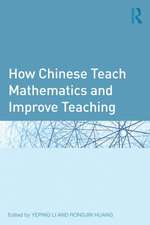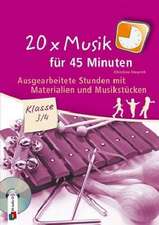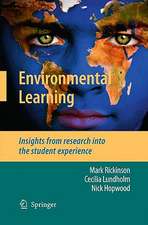Learning from Computers: Mathematics Education and Technology: NATO ASI Subseries F:, cartea 121
Editat de Christine Keitel-Kreidt, Kenneth Ruthvenen Limba Engleză Paperback – 14 dec 2011
Din seria NATO ASI Subseries F:
- 20%
 Preț: 650.27 lei
Preț: 650.27 lei - 20%
 Preț: 668.55 lei
Preț: 668.55 lei - 20%
 Preț: 992.44 lei
Preț: 992.44 lei - 18%
 Preț: 1239.19 lei
Preț: 1239.19 lei - 20%
 Preț: 1928.45 lei
Preț: 1928.45 lei - 20%
 Preț: 654.37 lei
Preț: 654.37 lei - 18%
 Preț: 1234.00 lei
Preț: 1234.00 lei - 20%
 Preț: 709.78 lei
Preț: 709.78 lei - 20%
 Preț: 656.03 lei
Preț: 656.03 lei - 18%
 Preț: 1854.94 lei
Preț: 1854.94 lei - 20%
 Preț: 374.97 lei
Preț: 374.97 lei - 20%
 Preț: 991.94 lei
Preț: 991.94 lei - 20%
 Preț: 671.02 lei
Preț: 671.02 lei - 20%
 Preț: 1925.96 lei
Preț: 1925.96 lei - 20%
 Preț: 994.73 lei
Preț: 994.73 lei -
 Preț: 389.49 lei
Preț: 389.49 lei - 20%
 Preț: 657.99 lei
Preț: 657.99 lei - 20%
 Preț: 655.20 lei
Preț: 655.20 lei - 18%
 Preț: 1225.31 lei
Preț: 1225.31 lei - 18%
 Preț: 952.09 lei
Preț: 952.09 lei - 20%
 Preț: 332.06 lei
Preț: 332.06 lei - 20%
 Preț: 1284.47 lei
Preț: 1284.47 lei - 20%
 Preț: 644.81 lei
Preț: 644.81 lei -
 Preț: 395.85 lei
Preț: 395.85 lei - 18%
 Preț: 1221.07 lei
Preț: 1221.07 lei - 20%
 Preț: 645.47 lei
Preț: 645.47 lei - 20%
 Preț: 1282.98 lei
Preț: 1282.98 lei - 20%
 Preț: 656.36 lei
Preț: 656.36 lei - 20%
 Preț: 1283.31 lei
Preț: 1283.31 lei - 20%
 Preț: 1924.15 lei
Preț: 1924.15 lei - 20%
 Preț: 362.24 lei
Preț: 362.24 lei
Preț: 643.34 lei
Preț vechi: 756.86 lei
-15% Nou
Puncte Express: 965
Preț estimativ în valută:
123.12€ • 126.08$ • 102.41£
123.12€ • 126.08$ • 102.41£
Carte tipărită la comandă
Livrare economică 18 martie-01 aprilie
Preluare comenzi: 021 569.72.76
Specificații
ISBN-13: 9783642785443
ISBN-10: 3642785441
Pagini: 356
Ilustrații: XIII, 332 p.
Dimensiuni: 155 x 235 x 19 mm
Greutate: 0.5 kg
Ediția:Softcover reprint of the original 1st ed. 1993
Editura: Springer Berlin, Heidelberg
Colecția Springer
Seria NATO ASI Subseries F:
Locul publicării:Berlin, Heidelberg, Germany
ISBN-10: 3642785441
Pagini: 356
Ilustrații: XIII, 332 p.
Dimensiuni: 155 x 235 x 19 mm
Greutate: 0.5 kg
Ediția:Softcover reprint of the original 1st ed. 1993
Editura: Springer Berlin, Heidelberg
Colecția Springer
Seria NATO ASI Subseries F:
Locul publicării:Berlin, Heidelberg, Germany
Public țintă
ResearchCuprins
1. Microworlds/Schoolworlds: The Transformation of an Innovation.- 1.1 The story of microworlds.- 1.2 The genesis.- 1.3 From designers to mathematics educators.- 1.4 Generating mathematics through microworlds: some illustrations.- 1.5 Evocative computational objects and situated abstractions.- 1.6 Microworlds in school mathematics.- 1.7 Microworlds in the curriculum.- 1.8 Reflections and implications.- 2. Computer Algebra Systems as Cognitive Technologies: Implication for the Practice of Mathematics Education.- 2.1 CAS: Some examples of symbol manipulations.- 2.2 Computers and computer algebras in relation to pure mathematics.- 2.3 Computer Algebra Systems in relation to mathematics education.- 2.4 Opposition to instructional uses of Computer Algebra Systems.- 2.5 Strengths of Computer Algebra Systems as learning tools.- 2.6 Computer algebra in an educational context: One example.- 2.7 CAS: From amplifiers to reorganisers.- 3. The Computer as Part of the Learning Environment: The Case of Geometry.- 3.1 The dual nature of geometrical figures.- 3.2 Difficulties of students.- 3.3 The notion of geometric figure as mediated by the computer.- 3.4 Changes brought by computers to the relationship to the figure.- 3.5 Interactions between student and software.- 4. Software Tools and Mathematics Education: The Case of Statistics.- 4.1 Didactical transposition and software tools.- 4.2 The revolution in statistics.- 4.3 Graphical and interactive data analysis: an example.- 4.4 Making sense of statistical software tools.- 4.5 Statistics education.- 4.6 Statistics and a re-defined school mathematics.- 5. Didactic Design of Computer-based Learning Environments.- 5.1 Understanding mathematics and the use of computers.- 5.2 Designing QuadFun - A case description.- 5.3 Interlude: Experimental aspects of mathematics.- 5.4 Design issues.- 5.5 A systemic view of didactic design.- 6. Artificial Intelligence and Real Teaching.- 6.1 Didactical interaction revisited.- 6.2 The input of artificial intelligence.- 6.3 Student-computer interaction, an overview.- 6.4 Educational software in the classroom, a new complexity.- 6.5 Open questions for future practice.- 7. Computer Use and Views of the Mind.- 7.1 The notion of cognition.- 7.2 Cognitive reorganization by using tools.- 7.3 Cognitive models and concreteness of thinking.- 7.4 Situated thinking and distributed cognition.- 7.5 The computer as a medium for prototypes.- 7.6 Modularity of thought.- 7.7 Conclusion.- 8. Technology and the Rationalisation of Teaching.- 8.1 The rationalisation of social practice.- 8.2 The elusive rationality of teaching.- 8.3 The marginal impact of machines on teaching.- 8.4 The dynamics of pedagogical change.- 8.5 The programming microworld.- 8.6 The tutoring system.- 8.7 The computer and the rationalisation of teaching.- 9. Computers and Curriculum Change in Mathematics.- 9.1 Locating the curriculum.- 9.2 Curriculum change as institutional change.- 9.3 Redefining school mathematics.- 9.4 Planning curriculum change.- 9.5 Alternative scenarios.- 10. On Determining New Goals for Mathematical Education.- 10.1 Goals for mathematics education.- 10.2 Goals for mathematics learners.- 10.3 Role of the teacher and the educational institution.- 10.4 Needed research on goals in mathematics education.- 11. Beyond the Tunnel Vision: Analysing the Relationship Between Mathematics, Society and Technology.- 11.1 Setting the stage.- 11.2 Technology in society.- 11.3 Mathematics shaping society?.- 11.4 Living (together) with abstractions.- 11.5 Mathematical technology as social structures.- 11.6 Structural problems in an abstraction society.- 11.7 Mathematics education as a social enterprise.- 11.8 Mathematics education as a democratic forum.- 11.9 Reflecting on computers in the classroom: Hardware-software-be(a)ware.- 12. Towards a Social Theory of Mathematical Knowledge.- 12.1 The Mechanistic Age - a historical introduction.- 12.2 Mathematical and social individuation.- 12.3 How can we master technology?.- 12.4 Engineers versus mathematicians since the turn of the century.- References.- Software.











